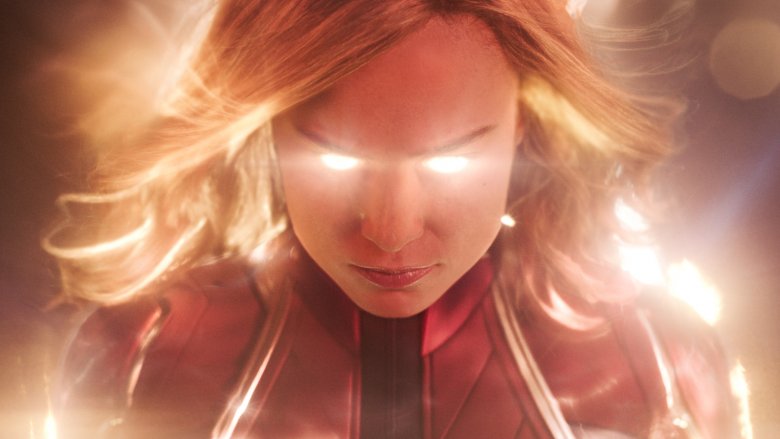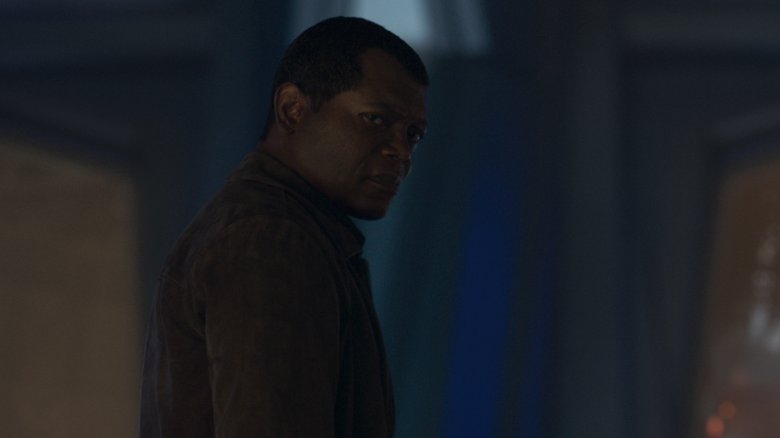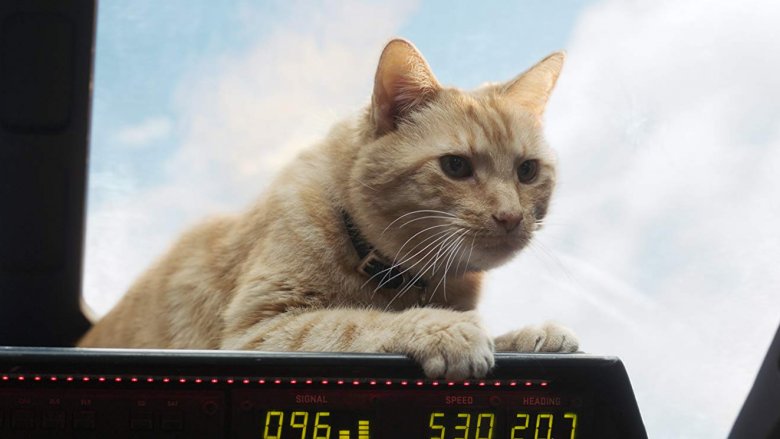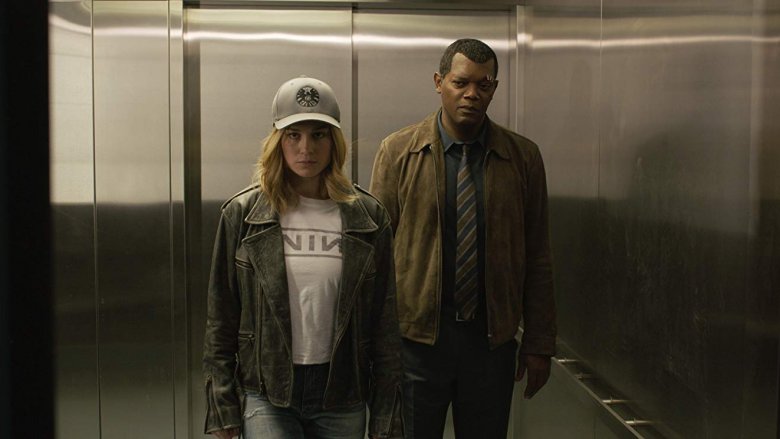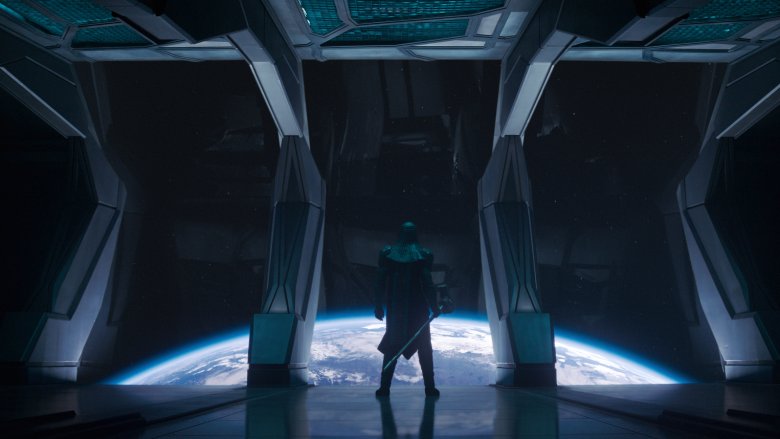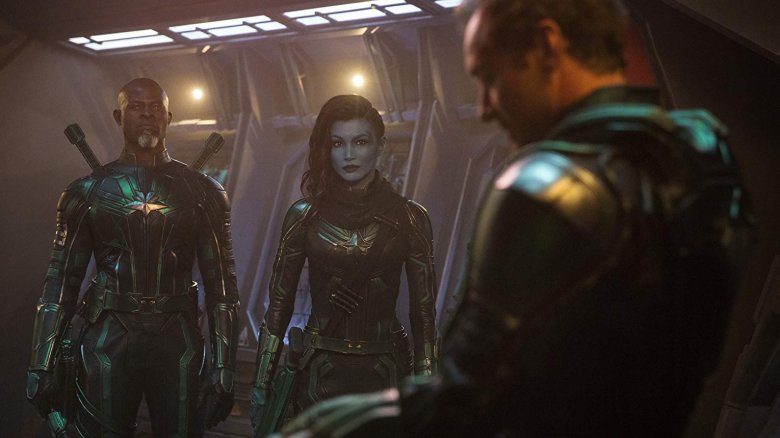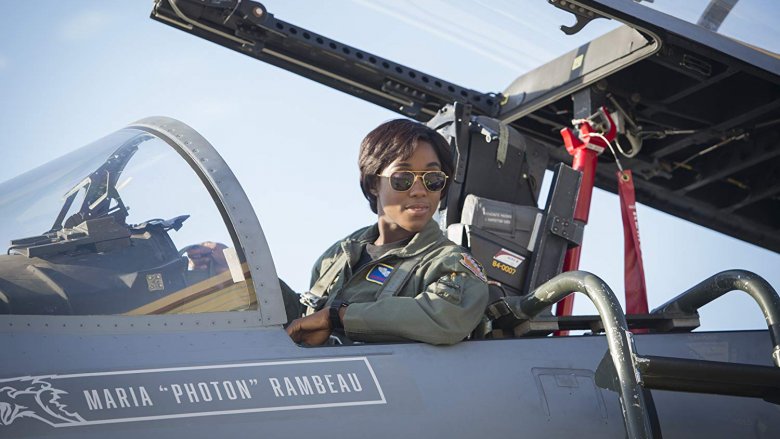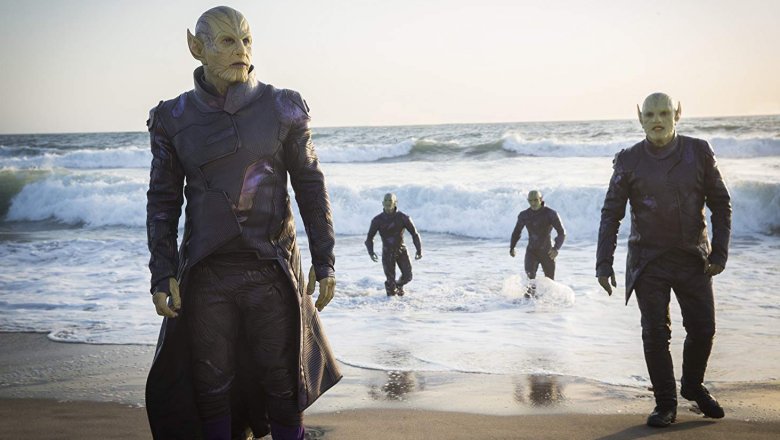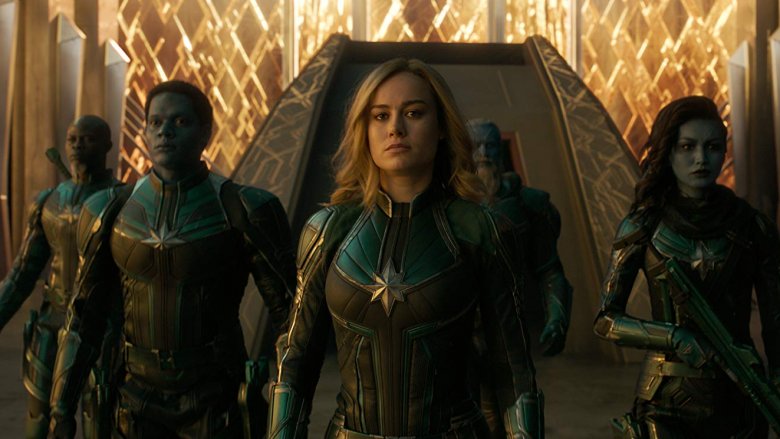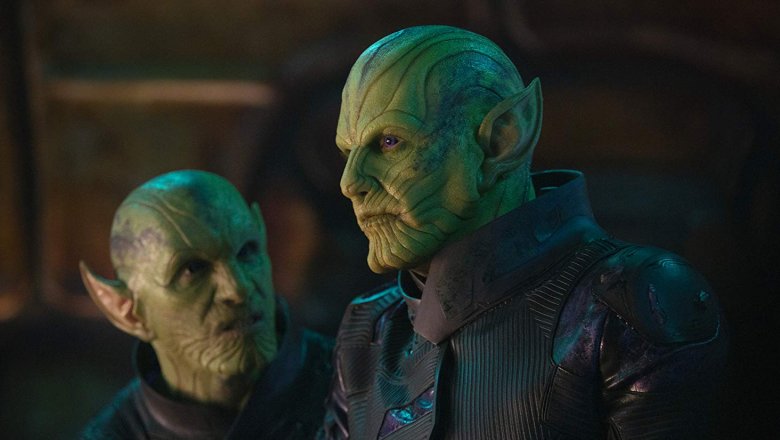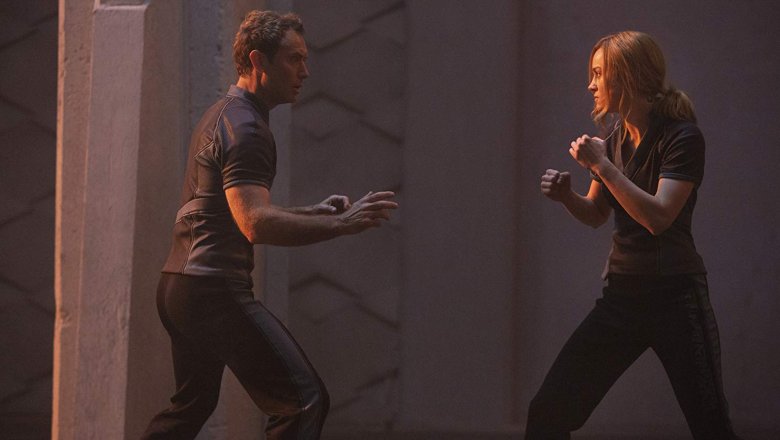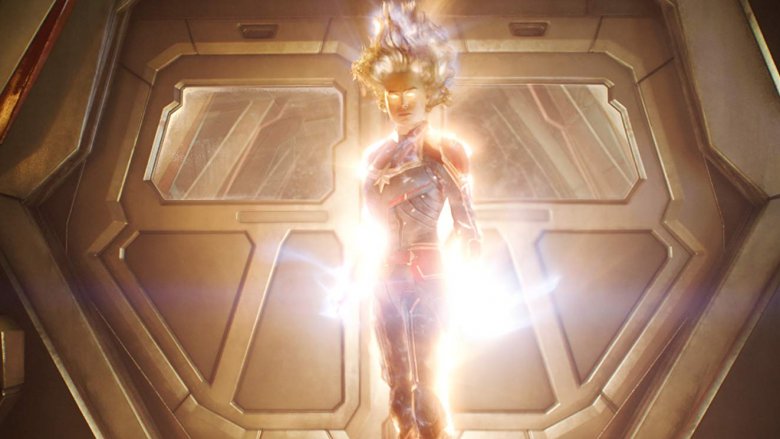The Biggest Unanswered Questions In Captain Marvel
This weekend, Captain Marvel finally hits theaters, and Marvel Studios' first ever female-led superhero release is taking flight. The film is noteworthy for a number of reasons, of course, even beyond its place as the first Marvel Cinematic Universe film with a sole female lead (Ant-Man and the Wasp did get there first with a female co-lead in its title) in Brie Larson's Carol Danvers.
For one thing, it's the introduction of the character who's often been touted as the most powerful hero in the MCU to date, and we get to finally see her powers at work in the film. For another, it's set in the 1990s, which means it features numerous prequel-like connections running throughout the MCU thanks to the presence of characters like Nick Fury (Samuel L. Jackson), Phil Coulson (Clark Gregg), and Ronan the Accuser (Lee Pace). All of this combines for a satisfyingly complex new web of storytelling, characters, and locations. Like most MCU releases, that means there are a lot of big implications left largely unexplored.
With that in mind, let's look at some of the biggest unanswered questions Captain Marvel leaves for us, from the future of the cosmic MCU to what transpires between this film and The Avengers. Oh, and MAJOR SPOILERS AHEAD for the entire film. You've been warned!
The Tesseract chain of custody
As is the case with so many Marvel Cinematic Universe efforts, Captain Marvel gives us yet another wrinkle in the history of the Infinity Stones. In this case, it's the Tesseract, the first Infinity Stone to make its way to Earth. We knew from past films that the Tesseract, a.k.a. the Space Stone, was found by HYDRA in the 1940s, recovered by SHIELD after Captain America's apparent death, and then stolen by Loki in the 2010s.
Now, we know that Dr. Wendy Lawson (Annette Bening), a.k.a. Mar-Vell, was a gifted Kree scientist who used the Tesseract as part of her work on Project Pegasus, powering a lightspeed engine with it before her death sometime around 1989.
In the six years between Mar-Vell's death and the rise of Carol Danvers as a superhero, the Tesseract apparently just sat hidden in her laboratory, in cloaked orbit above Earth, which raises a few questions. She was presumably allowed the use of it by S.H.I.E.L.D. as a government employee, so why didn't SHIELD come looking for it upon her death? Did they assume it was lost? Were they unable to track it? Was Mar-Vell the only one even in the highest levels of S.H.I.E.L.D. who knew about her lab? There are some interesting chain of custody questions here that further complicate the Tesseract's history in an amusing way.
A loyal pet's future
One of the standout stars of Captain Marvel (other than Brie Larson's title character and Jackson's Nick Fury) is Goose, Mar-Vell's cat who is found running around the Pegasus base on its own until it stows away onboard the ship Carol and Fury steal. By the end of the film, it's revealed that Goose is not a cat, but a Flerken, an alien species that appears as an Earth feline on the outside, but also packs deadly tentacles and the ability to apparently instantly consume objects several times its size.
This comes in handy in the film's climactic moments, as Goose is able to devour several Kree warriors, intimidate other aliens, and even eat the Tesseract so Fury himself won't have to touch it. Then, in the post-credits scene, we see Goose casually cough the Infinity Stone up onto Fury's desk so it can be transferred back into S.H.I.E.L.D. custody (and probably secure Fury the first of many promotions). After all that, though, we're still left wondering quite a bit about Goose. What's a Flerken's lifespan? Could Goose still be hanging around the MCU somewhere? Does Fury still keep Goose as a pet? We may never know.
The rise of Fury
One of the great joys of this film is watching a younger Nick Fury (Samuel L. Jackson). This Fury still has both of his eyes for the duration of the film, and he's also still rather green as a S.H.I.E.L.D. agent, with an ID badge that shows his clearance level at the organization is only Level 3.
As we know from the various MCU films and TV series, there are several clearance Levels within S.H.I.E.L.D., with the highest numeric level set at 10 and a couple of even more secretive levels above that, which is where Fury eventually ends up. The film ends in roughly 1995, which gives him a little more than a decade to achieve his place as director of the organization by the time he meets Tony Stark in 2008.
We know he gets the director job after forming a relationship with Alexander Pierce (Robert Redford in Captain America: The Winter Soldier), who left that position to become Secretary of the World Security Council and handed S.H.I.E.L.D. over to Fury. What we don't know is exactly how long that took and how that happened. Fury's rise through the ranks, if he's only at Level 3 in this film, was certainly meteoric. It would be very interesting to see the rest of that rise over the next decade, particularly since the film ends as he's developing his pitch for the Avenger Initiative.
Ronan's ambition
Though he's not in the movie for very long, Captain Marvel features more familiar faces form the past than just a young Nick Fury and Phil Coulson. We also get the return of Ronan the Accuser (Lee Pace), the Kree dispatcher of justice who was the primary villain in Guardians of the Galaxy, which is set nearly two decades after the events of Captain Marvel. In that film, Ronan is a rogue Accuser who becomes a terrorist fanatic after his people sign a peace treaty with Xandar. In this film, he's still following the instructions of the Kree government and making bombing runs on reported Skrull hiding places, working in close collaboration with Yon-Rogg (Jude Law) and the rest of the Starforce.
We know that between this film and Guardians of the Galaxy Ronan goes rogue, defies his people, and ultimately dies in a struggle over the Power Stone. At the end of Captain Marvel, though, he tells a cohort that he will one day return for "the weapon," referring to Carol in her superpowered state. So... does he ever return for her? Obviously she leaves Earth at the end of the film, but did he and the other Accusers ever try to seek her out in space? Is that one of the Captain Marvel sequels we might see? We can't know right now, but filling in the gaps of Ronan's MCU history could be interesting.
Korath's future
Ronan isn't the only Kree character to return from Guardians of the Galaxy. We also get a look at a younger version of Korath the Pursuer (Djimon Hounsou), who by the end of his life is one of Ronan's top lieutenants in his quest to destroy Xandar after breaking off from the rest of the Kree Empire. Korath's eventual defection to following Ronan is hinted at only briefly, in a scene in which he seems willing to tell the Accuser more than Yon-Rogg about Carol's whereabouts. The last time we see Korath in the film, though, he's battling Carol during the climax, only to be defeated along with the rest of the Starforce.
Korath's state at the end of Captain Marvel isn't exactly clear, but we know he returns in Guardians of the Galaxy with several enhancements (including equipment grafted into his head), and he seems to be following Ronan with no regard for the greater Kree government. What happened between the end of this film and the start of that one? Did Ronan give Korath his enhancements? Was he essentially resurrected by the Accuser? Again, there are plenty of gaps here that other movies could fill in.
The heroic Rambeaus
One of the most exciting pieces of largely unexplored potential storytelling energy in Captain Marvel is the presence of the Rambeau family, including Carol's best friend Maria (Lashana Lynch) and her daughter Monica (Akira Akbar), who idolizes "Auntie Carol" when she's a pilot, even more so when it becomes clear that she's a superhero.
By the end of the film, both mother and daughter know exactly who Carol is and what she can do, and "Lt. Trouble" Monica is excited by the idea that she too could grow up to be a hero like her mother and her auntie. In Marvel Comics, she actually does. Monica Rambeau actually held the Captain Marvel title long before Carol did, way back in 1982. She has since shifted superhero identities in the pages of Marvel Comics several times and is currently known as Spectrum. By any name, she's a vital hero in the Marvel Universe who once led the Avengers and can summon tremendous power of her own.
The film is clearly teasing that Monica will have her own superheroic future one day, and the timeline is such that she'd be in her 30s by the time the present day MCU events happen. Will we see a version of Monica Rambeau appearing soon in one of her non-Captain Marvel superhero identities?
A Skrull empire?
We spend much of the runtime of Captain Marvel, like Carol, believing what we've been told by the Kree: that the Skrulls are an evil, insidious force that will infiltrate any planet they care to conquer via their shapeshifting abilities, and ultimately take it over. The Supreme Intelligence tells us this, Yon-Rogg tells this, and even Carol tells us this. One of the film's great twists is that this is apparently false. The remaining Skrulls in the galaxy are actually refugees, running from the Kree rather than attempting to defeat them as they look for a new home, something Mar-Vell was hoping to solve with her lightspeed engine. With Carol's help, they eventually head off into the stars to find a new planet to settle on, and that's the last we hear of them.
Do the Skrulls find a planet to call home? If they do, then they've had more than two decades to colonize and rebuild (assuming it happened somewhat quickly) since the events of Captain Marvel. What is Skrull life like now? Will they eventually become an expanding power in the galaxy again? One of the great hallmarks of their comic book history is the resilience of the Skrulls, and their ability to rise up and even conquer again and again after they're decimated by various forces, sometimes as humanity's enemy and sometimes as our ally. With all of that in mind, where are the Skrulls now, and whose side are they on?
A larger war
Though it's largely used as a backdrop for what is ultimately Carol's own journey of self-discovery, Captain Marvel provides us with the first-ever big-screen representation of the Kree-Skrull War, one of Marvel Comics' most famous events and one of its first major cosmic storytelling initiatives. The war between these two alien races is a foundational event in the Marvel Universe, setting the stage for increasingly massive cosmic sagas involving numerous other alien races for decades to come.
What the film doesn't tell us in any great detail (similar to the way the Kree-Xandar War is treated in Guardians of the Galaxy) is where the roots of the war lie, how each side got involved, how the Skrulls became refugees in the first place, how strong they were before the Kree began to decimate them, or much of anything else. Again, this war is a backdrop for the conspiracy story playing out as Carol seeks to uncover her memories, but there's a lot of unexplored territory here, all of which could be fodder for future movies, as well as supplemental materials like novels and comic book spin-offs.
Powerful memory technology
Early in the film, well before we learn of their true intentions, it's revealed that under the leadership of Talos (Ben Mendelsohn), the Skrulls have developed a new kind of memory probing technology that allows them to, among other things, replay the memories of a subject over and over again and enhance various details to extract information. In one of the film's most impressive sequences, this Skrull machine takes us on a journey through Carol's own fragmented memories, as Talos and company comment on what they're seeing in voice-over and repeatedly rewind various moments from Carol's past as they try to find the location of the lightspeed engine.
Eventually, Carol and the rest of the Starforce learn that the Skrulls have been using this technology to enhance their simulations of non-Skrull beings, as it allows them to extract more than recent memories from subjects and thus create a more convincing imitation. Then, as the main thrust of the plot becomes clear, discussion of this apparently new technology ceases, though the Skrulls presumably still have it. Now that they're on the hunt for a new home, and presumably about to reboot their civilization, what will they use it for? Could they sell it for other resources? Will they one day use it as an instrument of war again? No matter what they do, this powerful memory manipulation technology is now part of the MCU, and it could easily fall into the wrong hands.
The fate of Yon-Rogg
One of the film's biggest twists (and arguably one of its most obvious) comes in the moment when Carol finally remembers how she got her powers and ultimately arrived at the Kree homeworld of Hala. After the ship carrying her and Mar-Vell was shot down by an alien craft, she was set upon by Yon-Rogg, who killed Mar-Vell in an effort to prevent the use of the lightspeed engine and thus prolong the slaughter of the Skrulls on behalf of the Kree people. When Carol destroyed the engine and absorbed its power, Yon-Rogg chose to abduct rather than kill her, and hid her own memories and her true nature from her for six years. After Carol finds out, she defeats her former mentor in combat and sends him back to Hala, where he will no doubt face retribution for having killed one of his own and then staged a cover-up.
The question is, then, what happens to Yon-Rogg? Is he executed? Is he sentenced to prison? Does he have a chance of eventually finding freedom and going rogue like Ronan eventually did? Will we ever see him again? In a universe this complex, anyone left alive is potentially fodder for sequels.
The implications of power
Carol Danvers receives her powers when she destroys Mar-Vell's lightspeed engine rather than give it to Yon-Rogg. The resulting blast envelops her, granting her superhuman strength, speed, resilience, and the photon blasts that become her defining power. A short while later, we learn that the engine Mar-Vell built derived its power from a core that turns out to be the Tesseract, also known as the Space Stone, an object of tremendous power that's played numerous major roles in the Marvel Universe.
We know that the Space Stone is able to transport its bearer across great distances, as it did with the Red Skull (accidentally) in Captain America: The First Avenger and with Thanos (on purpose) in Avengers: Infinity War. We also know that it can apparently be triggered from afar, as Loki did (perhaps with the aid of the Mind Stone) in The Avengers. Carol Danvers gets her power from it, just as Vision derived some of his abilities from the Mind Stone embedded in his head.
Does that mean she can manipulate the Space Stone or use some fraction of its abilities in some way? Is she as intimately connected to it as Vision is to the Mind Stone? If she focuses enough, can she teleport as well as travel space really fast? These are enormous questions, and Avengers: Endgame might ultimately provide us with some answers.
